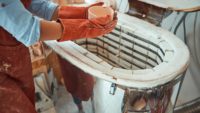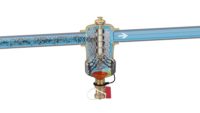The year 1979 was great for transitions — I struck out on my own on Sept. 1, 1979 to pursue the American Dream of owning my own business and charting my destiny.
No fear of the unknown, well, maybe some trepidation, but Lois and I were determined to give it our best shot. Prior to that date, I attended a weekday auction because a plumber/HVAC contractor had transitioned to the other side of the lawn. I went home with the tools and inventory needed for a great start.
A good friend opened a business selling wood and coal boilers manufactured by Eshland. Always a firm believer in getting certified training before installing products in my customers’ homes, I attended a multi-day course at Eshland Enterprises for the proper installation of their coal and wood boilers. Background: my grandparents lived in Saint Clair, Pennsylvania, in the heart of the anthracite coal region. Pop-Pop had a Westinghouse appliance store and provided service on everything he sold. He also serviced coal boilers and pretty much every home heated with coal. As a young lad, I very much looked forward to tagging along on service calls and eagerly anticipated the hands-on experiences. Pop-Pop was, to put it in perspective, built like Santa Claus and would have needed no padding, so my skinny self fit into and under spaces conducive for active involvement — with supervision and guidance of course.
One thing I recall clearly about the Eshland wood and coal boilers was the safety controls built into each boiler. In the event there was a loss of power, the automatic air shutter(s) would begin closing as internal water temperature would rise and completely close off combustion air if the hydronic water temperature rose past the adjustable setting, which was normally 190° F. Residual heat would dissipate via gravity circulation until power was restored. In those days, I was armed with nothing more than a hand-truck and more muscle than brains! Eshland boilers were very heavy and, thankfully, virtually every installation was either a walk-in basement or assisted by gravity going down the stairs.
My friend, the Eshland dealer, asked me to meet with him on a very remote farm. The farmer had free firewood due to acres of woodland and had a wood stove in very good working condition. He also had an oil-fired boiler connected to hot water baseboards and wanted to transition his wood stove to a wood boiler.
As was typical for many farmers in our area, he had his own welding machine and would do whatever we instructed to construct a water jacket. I helped him come up with a plan, which closely copied Eshland’s design. He first welded all seams on the existing wood stove to help ensure no internal leaks would be present, welded studs onto the existing plates, which would protrude through the external water-jacket to help solidify the walls from flexing and added threaded weldolets for controls and the inlet/outlet. With help from the Eshland certification course, the appropriate relief valve was installed and discharge piped safely away from the immediate area. The beast we created worked exactly as desired, which allowed the farmer and his family to travel during winter months knowing that once the wood fire would not be providing adequate heat energy to maintain the desired thermostat setting, the oil boiler would begin stepping in to supplement the heating.
One installation that stands out in memory was on a farm where a too-small coal-fired replacement boiler could not sustain sufficient heat output overnight and the farmer had to get up at 3 a.m. to add more coal in order to keep warm. He was not a happy camper and was looking for a solution. He was born and raised on the farm and had been responsible for maintaining the coal fires for many decades. With the new Eshland coal boiler, he went from a 20-pound firebox to one that could hold more than 200 pounds! He now found he could go for three days before having to add more coal, and got the peaceful rest he desired.
A few decades later, we installed an oil-fired “backup” boiler so he could travel during winter without worrying about heating. As the coal fire winds down, the oil-fired boiler can step in to supplement or provide 100% of the heating needs.
The transition: from coal and oil to mini-split inverter heat pumps! A whole farmhouse approach, which included two multi-head condensers with four concealed mini-air-handlers to serve the four second-floor bedrooms, and a combination of wall and floor-mounted indoor heads to serve the first floor. From one of the first jobs I performed in 1979 to one of the last installations before selling our business end of 2019.
When old age and a bad back dictated a required change from shoveling coal, and myself approaching retirement, my decades-long farmer customer was looking for a transition to better energy efficiency and had grown weary of the several weeks of stifling heat and humidity that grip our region.
“I’ve never had air conditioning and don’t see a need to have central air conditioning as that seems like a waste of energy. Is there anything I can have installed to eliminate using my coal boiler?”
We discussed a major transition that made perfect sense to me because we’ve done this literally hundreds of times, but knowing how frugal this gentleman was, I tread carefully while explaining his options.
The transition: from coal and oil to mini-split inverter heat pumps! A whole farmhouse approach, which included two multi-head condensers with four concealed mini-air-handlers to serve the four second-floor bedrooms, and a combination of wall and floor-mounted indoor heads to serve the first floor. From one of the first jobs I performed in 1979 to one of the last installations before selling our business end of 2019. He also wanted the Eshland coal boiler removed and hauled away, which would have required an army of strong backs to move that beast up the basement steps, but as he had done many times, our farmer pitched in whenever needed and used his tractor’s front-end-loader to hoist that old boiler up and out of the basement. It tipped the scales at the scrapyard — a bit over 2,000 pounds! He can now heat or cool individual areas/rooms to suit his comfort needs and do so efficiently while reducing his operating costs. No more shoveling coal, cleaning out the shaker-pit or carrying heavy ash/cinders up those steep concrete basement steps.
Happy New Year to you all as we transition to 2024! Go forth and prosper.




